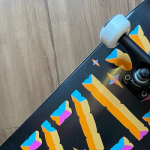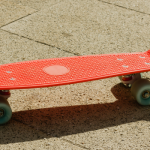As someone who’s passionate about hitting the pavement and cruising on four wheels, I understand the bond we share with our trusty skateboards.
Whether you’re a seasoned pro or just starting out, knowing when to bid farewell to your deck is crucial for maintaining peak performance and, more importantly, ensuring your safety on the streets or at the park.
In this short guide, we’ll delve into the signs that indicate it’s time to part ways with your current skateboard deck.
From wear and tear to structural integrity, I’ll help you navigate the decision-making process so you can keep shredding with confidence.
Let’s make sure your setup is always in top-notch condition for those epic sessions ahead!
So, when should i replace my skateboard deck?
Knowing when to replace your skateboard deck is essential for maintaining optimal performance and preventing potential safety hazards. Here are some key indicators that it might be time to retire your current deck:
Cracks and Chips: Regular use can lead to inevitable wear and tear, but when you start noticing significant cracks or chips on your deck, it’s a clear sign that its structural integrity is compromised. A cracked deck can break unexpectedly, posing serious risks.
Delamination: Delamination occurs when the layers of a skateboard deck start separating. If you notice bubbles or raised areas on the deck’s surface, it’s a sure sign that the glue holding the layers together is failing. Riding on a delaminated deck can result in a loss of control.
Extreme Warping: Over time, exposure to moisture and changes in temperature can cause your deck to warp. While some minor warping is natural, excessive curvature or twisting can affect your riding experience and make tricks more challenging.
Loss of Pop: A skateboard deck’s pop is its ability to provide a responsive and energetic feel when performing tricks. As a deck wears out, you may notice a gradual loss of pop, making it harder to execute tricks that require a snappy response.
Tail and Nose Wear: Pay attention to the wear on the tail and nose of your skateboard. As these areas flatten out over time, it becomes more challenging to control the board during tricks and maneuvers.
Spongy Feel: If your deck starts feeling spongy or overly flexible, it’s a sign that the wood has softened due to wear and use. A compromised deck can affect stability and responsiveness.
How often should you replace your deck?
There is no set timeframe for replacing a skateboard deck, as it largely depends on the individual’s riding style and frequency.
However, most skaters replace their decks every 2-3 months with regular use. If you’re an avid skater or participate in competitive events, you may find yourself replacing your deck more frequently.
On the other hand, occasional or recreational skaters may be able to extend the lifespan of their deck.
It’s important to regularly inspect your deck and pay attention to any signs of wear and tear. If in doubt, it’s always better to err on the side of caution and replace your deck sooner rather than later.
How do I know if my skateboard deck is good quality?
Now that you know when to replace your skateboard deck, it’s essential to understand what makes a high-quality deck in the first place. Here are some key factors to consider:
Material and Construction:
Quality skateboard decks are typically made from seven to nine layers of maple wood, which provides a perfect balance of strength and flexibility.
Look for decks with high-quality, hard rock maple as it offers durability and a consistent pop.
Also, premium decks often have a strong glue and cold-press construction, ensuring that the layers are tightly bonded for a solid and reliable ride.
Concave and Shape:
Pay attention to the deck’s concave and shape, as these factors significantly impact your performance.
A good-quality deck features a well-defined concave – the curvature along the width of the deck. This concave enhances board control and facilitates flip tricks.
The shape should also align with your personal preferences, whether you prefer a steep or mellow concave and a wider or narrower deck.
Brand Reputation:
Stick to reputable skateboard brands with a history of producing quality decks.
Established brands invest in research, development, and testing to ensure their decks meet the demands of various skating styles.
Reading reviews and seeking recommendations from experienced skateboarders can help you identify brands with a track record of delivering high-quality decks.
Graphics and Finish:
While graphics are subjective, a quality deck often reflects attention to detail in its artwork and finish.
Look for decks with high-resolution, durable graphics that are applied using advanced printing techniques.
A clear and durable grip tape applied evenly to the deck’s surface is another indicator of quality craftsmanship.
Quality graphics and finish not only contribute to aesthetics but also reflect the manufacturer’s commitment to the overall quality of the product.
Pro Rider Endorsements:
Decks endorsed by professional skateboarders often indicate a high-quality product.
Pro riders typically choose decks that meet their performance standards, and their endorsements can be a testament to the deck’s durability, pop, and overall feel.
Keep an eye out for collaborations between professional skateboarders and reputable deck manufacturers, as these partnerships often produce top-tier products.
Conclusion
Your skateboard deck is the foundation of your riding experience, and knowing when to replace it is crucial for optimal performance and safety.
Regularly inspect your deck for signs of wear and tear, and don’t hesitate to replace it if you notice any significant damage or decrease in performance.
When choosing a new deck, consider factors such as material, construction, concave, brand reputation, graphics, and pro rider endorsements to ensure you get a high-quality product that meets your skating needs.
So keep these factors in mind as you continue to perfect your skateboarding skills and have fun on the streets or at the park.
![Why do skateboarders hate scooters? [Reasons + Tips] Why do skateboarders hate scooters? [Reasons + Tips]](https://bedoper.site/wp-content/uploads/2023/04/Why-do-skateboarders-hate-scooters-150x150.png)


![How fast do skateboards go downhill? [90 mph (145 km/h)] How fast do skateboards go downhill? [90 mph (145 km/h)]](https://bedoper.site/wp-content/uploads/2023/04/How-fast-do-skateboards-go-downhill-150x150.png)
